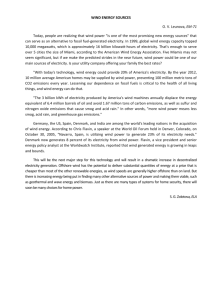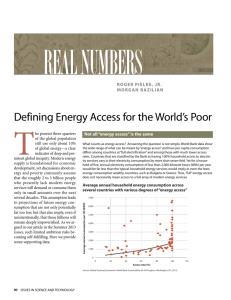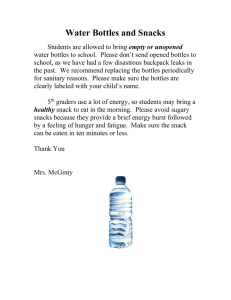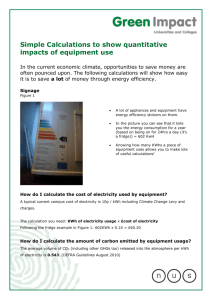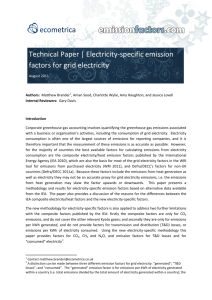problem 1
advertisement
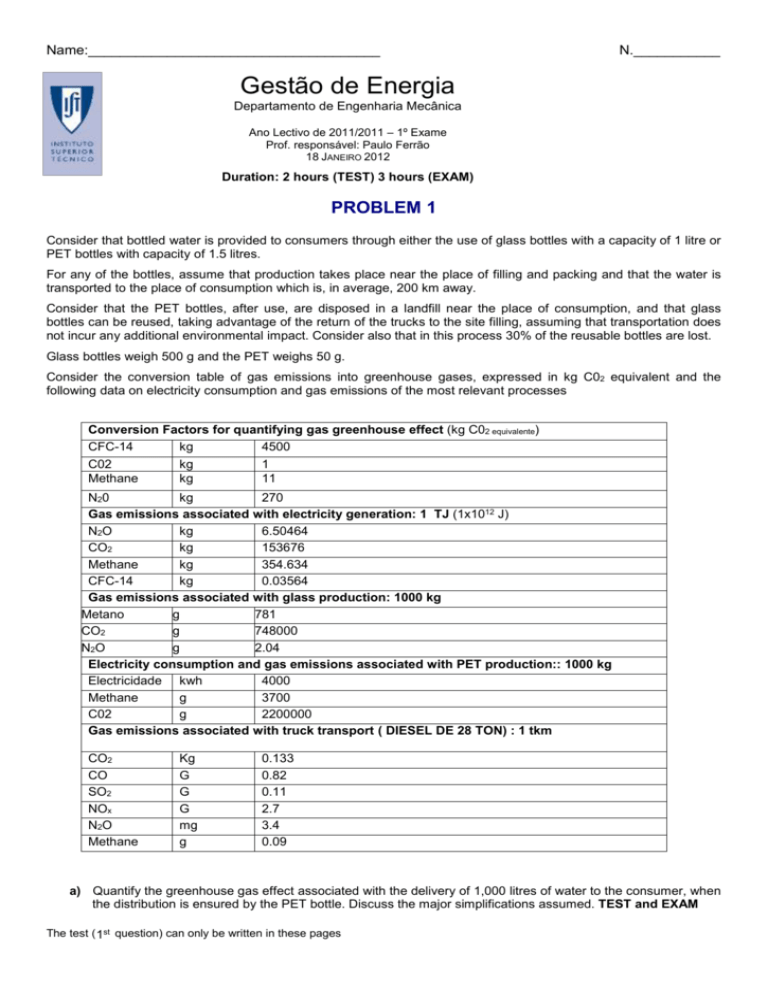
Name:_____________________________________ N.___________ Gestão de Energia Departamento de Engenharia Mecânica Ano Lectivo de 2011/2011 – 1º Exame Prof. responsável: Paulo Ferrão 18 JANEIRO 2012 Duration: 2 hours (TEST) 3 hours (EXAM) PROBLEM 1 Consider that bottled water is provided to consumers through either the use of glass bottles with a capacity of 1 litre or PET bottles with capacity of 1.5 litres. For any of the bottles, assume that production takes place near the place of filling and packing and that the water is transported to the place of consumption which is, in average, 200 km away. Consider that the PET bottles, after use, are disposed in a landfill near the place of consumption, and that glass bottles can be reused, taking advantage of the return of the trucks to the site filling, assuming that transportation does not incur any additional environmental impact. Consider also that in this process 30% of the reusable bottles are lost. Glass bottles weigh 500 g and the PET weighs 50 g. Consider the conversion table of gas emissions into greenhouse gases, expressed in kg C02 equivalent and the following data on electricity consumption and gas emissions of the most relevant processes Conversion Factors for quantifying gas greenhouse effect (kg C02 equivalente) CFC-14 kg 4500 C02 kg 1 Methane kg 11 N20 kg 270 Gas emissions associated with electricity generation: 1 TJ (1x1012 J) N2O kg 6.50464 CO2 kg 153676 Methane kg 354.634 CFC-14 kg 0.03564 Gas emissions associated with glass production: 1000 kg Metano g 781 CO2 g 748000 N2O g 2.04 Electricity consumption and gas emissions associated with PET production:: 1000 kg Electricidade kwh 4000 Methane g 3700 C02 g 2200000 Gas emissions associated with truck transport ( DIESEL DE 28 TON) : 1 tkm CO2 CO SO2 NOx N2O Methane Kg G G G mg g 0.133 0.82 0.11 2.7 3.4 0.09 a) Quantify the greenhouse gas effect associated with the delivery of 1,000 litres of water to the consumer, when the distribution is ensured by the PET bottle. Discuss the major simplifications assumed. TEST and EXAM The test ( 1st question) can only be written in these pages b) Quantify the greenhouse gas effect associated with the delivery of 1,000 litres of water to the consumer, when the distribution is ensured by glass bottles. Discuss the major simplifications assumed. TEST and EXAM Discuss the following statements: c) Hydrogen is the fuel of the future, since its conversion into electricity through fuel cells does not cause any CO2 emissions. EXAM d) We intend to conduct a life cycle assessment of different paints, in order to compare the environmental impact of painting a house, for different paint brands available in the market. Which functional unit should you define? Jusify. EXAM The test ( 1st question) can only be written in these pages Name:_____________________________________ The test ( 1st question) can only be written in these pages N.___________ The test ( 1st question) can only be written in these pages Name:_____________________________________ N.___________ PROBLEM 2 The functioning of a factory is described by unitary productive operations A to D and by a treatment operation T, as represented in the matrix below. The matrix of inter-operation mass flows and the vectors of raw material inputs and final mass outputs (expressed in ton) in the current year are as follows. Final A B C D T A 0 0 950 0 0 0 B 0 0 0 1500 0 0 C 0 0 0 1000 0 0 D 0 0 0 0 500 2000 T 0 0 50 0 0 450 Raw Material Input 950 1500 0 0 0 Output In adition, operation A requires the consumption of 600 m3 of natural gas per ton of product processed and operation T requires the consumption of 2525 kWh of electricity per ton of treated waste. The specific consumption of the remaining unitary operations is negligible. Density of NG = 0.8404 kg/m3; LHV of NG = 1.077 toe/ton; Primary energy associated to electricity generation = 0.215 toe/MWh. Considering this description of the factory, please answer the following questions: a) Represent the block diagram that corresponds to the matrix above and calculate the values of all non-trivial mass coefficients and specific consumptions of the unitary operations (the latter in units of toe/ton). TEST AND EXAM b) Calculate the specific consumption of the productive final output. TEST AND EXAM c) Consider that the specific energy consumption of the treatment operation T is a quadratic function CE T = K(1+x2), where K is a constant and x is the fraction of recycled waste. Consider also that the recycled flow is indistinguishable from the output of operation A. If the productive final output remains constant and x is increased to 50%, how does total energy consumption change? TEST AND EXAM d) Will x = 50% be the best option (given a constant productive final output)? TEST AND EXAM e) Is the factory initially under the conditions of the SGCIE? If so, indicate the legal obligations that the factory needs to comply with. EXAM f) Examine whether the shift in the recycling fraction of question (c) is enough to meet the legislation requirements. Consider that the GHG emission factors of natural gas = 2.68 tonCO2eq/toe and electricity = 0.47 tonCO2eq/toe. EXAM The test ( 2nd question) can only be written in these pages The test ( 2nd question) can only be written in these pages Name:_____________________________________ The test ( 2nd question) can only be written in these pages N.___________ The test ( 2nd question) can only be written in these pages Name:_____________________________________ N.___________ PROBLEM 3 1. Consider a house (T1) in the Lisbon region (region I1-V2 with GD 1190) with a form factor of 0.7 m-1 and an area of 65 m2. According to RCCTE, the estimated needs for thermal heating, cooling and domestic hot water (final energy in this case), are: Nic = 50 kWh.m-2.ano-1, Nvc = 15 kWh.m-2.ano-1, Nac = 25 kWh.m-2.ano-1, respectively. a. Is this house in accordance with the maximum values imposed by RCCTE regarding heating, cooling and domestic hot water for new residential homes? EXAM and TEST b. Why do you think that the Ni and Nv values imposed by legislation are useful energy and not final energy? EXAM and TEST c. What is the energy rating of this house taking into account that the heating and cooling are achieved using an air conditioner (powered by electricity) with a COP of 2 (for cooling) and a COP of 3 (for heating) and hot water is obtained with a water heater fueled by natural gas with an efficiency of 0.88? EXAM and TEST d. What does each of the three terms in the equation of Ntc represent? And what do you think is the aim of having a coefficient of 0.1 in the first two terms? EXAM and TEST Ntc = 0,1 (Nic/ηi)Fpui + 0,1 (Nvc/ηv)Fpuv + Nac Fpua DATA: V2(South)=32 kWh.m-2.ano-1, Electricity: 0.290 kgep.kWh-1, Natural Gas: 0.086 kgep.kWh-1 The test ( 3rd question) can only be written in these pages The test ( 3rd question) can only be written in these pages Name:_____________________________________ The test ( 3rd question) can only be written in these pages N.___________ The test ( 3rd question) can only be written in these pages



